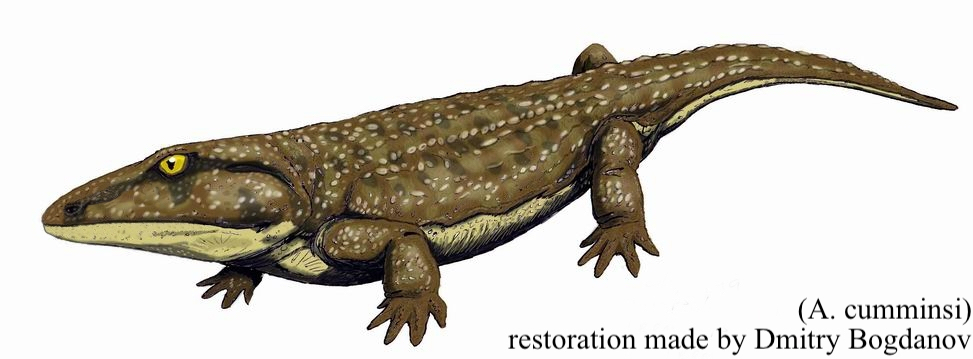Welcome to Acheloma

Name Definition
unavailable
Name Given By
Edward Drinker Cope in 1882/A. cumminsi ; Brendan P. Polley and Robert R. Reisz in 2011/A. dunni
Location
Richards Spur in Oklahoma ; Arroyo Formation in Texas ; Washington Formation of Ohio ; all in the U.S.
Classification
Batrachomorpha, Temnospondyli, Dissorophoidea, Olsoniformes, Trematopidae
Size
size is unavailable but it would have been large for a trematopid temnospondyl
Temporal Range
Kungurian - Roadian stages of the mid-Permian, around 280 - 273 million years ago
Ecological niche
large (compared to other tetrapods of its time) amphibious carnivore
Species/Sub Species
A. cumminsi (type species), A. dunni
Diet
While it was small compared to later tetrapods, Acheloma was probably the apex predator of its ecosystem and hunted terrestrial prey as well as prey in the waters
Introduction
Acheloma is a genus of temnospondyl tetrapods that lived in the U.S. during the Mid-Permian.
The type species of Acheloma, A. cumminsi, was originally named by Edward Drinker Cope in 1882, and the description was based on a partial skull and some other associated postcranial remains unearthed from the Arroyo Formation of Texas. The specimen of A. cumminsi is currently being housed in the American Museum of Natural History in New York. After the discovery of Acheloma, some other large trematopids were discovered from the Arroyo Formation including the one that gave the family its name, Trematops, however the two Trematops species T. milleri and T. willostoni have since been considered synonymous with Acheloma cumminsi. Two other Trematops species, T. stonei from the Washington Formation of Ohio and T. thomasi from Oklahoma, have also been considered to be synonymous with Acheloma cumminsi. A second species of Acheloma (A. dunni) was discovered in the Richards Spur fossil locality in Oklahoma and was described by Brendan P. Polley and Robert R. Reisz in 2011.
Acheloma is often perceived as a large amphibious tetrapod that was one of the top predators in its environment. Given it was the Permian period though, it was clear that tetrapods diversified into many forms including larger predators, so Acheloma was not an apex predator and instead would have hunted smaller reptiles and animals on land while it would have hunted small fish and invertebrates in the water too. There have been various studies that have confirmed the theory that Acheloma was a terrestrial temnospondyl, meaning that it would have been able to stay on land for extended periods of time. Acheloma lived with a wide variety of Permian paleofauna including lepospondyl amphibians such as Diplocaulus, other temnospondyl amphibians such as Eryops, Cacops, and the more closely related Dissorophus, terrestrial seymouriamorph amphibians such as Seymouria, the large reptiliomorph Diadectes, multiple synapsids like Dimetrodon and Edaphosaurus, and some lizard-like reptiles.